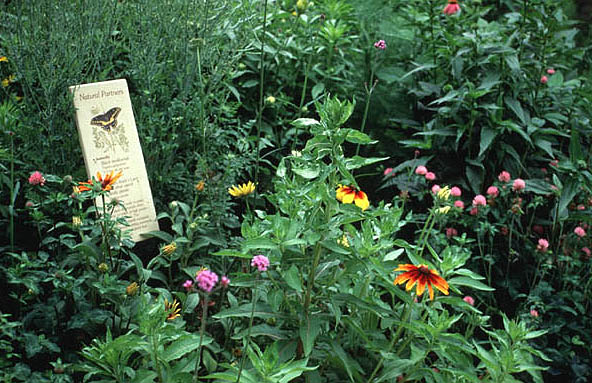 Nectar Sources:
Nectar Sources:
Caterpillar (Larval) Food Sources:
Other Important Information
|
Chinaberry
|
Mimosa
|
Rusty Blackhaw
|
|
Chaste Tree
|
Black Cherry
|
Huisache
|
|
Golden-ball Lead Tree
|
Mesquite
|
Mexican Plum
|
|
Redbud
|
|
Globe Amaranth
|
Butterfly Weed
|
Calendula
|
|
Aster
|
Chrysanthemum
|
Cigar Plant
|
|
Purple Coneflower
|
Cosmos
|
Daylily
|
|
Geranium
|
Goldenrod
|
Impatiens
|
|
Marigold
|
Pansy
|
Pentas
|
|
Plumbago
|
Mexican Bush Sage
|
Speedwell
|
|
Mexican Sunflower
|
Thistle
|
Zinnia
|
|
Bergamot
|
Blackfoot Daisy
|
Bluebonnet
|
|
Brown-eyed Susan
|
Cardinal Flower
|
Columbine
|
|
Frostweed
|
Indian Blanket
|
Gayfeather
|
|
Mexican Hat
|
Indian Paintbrush
|
Salvia sp.
|
|
Maximillian Sunflower
|
Yarrow
|
Coreopsis
|
|
Phlox
|
Purple Horsemint
|
|
Glossy Abelia
|
Butterfly Bush
|
Hibiscus
|
|
Lantana
|
Flame Acanthus
|
Agarita
|
|
Bird of Paradise
|
Mexican Buckeye
|
Red Buckeye
|
|
Buttonbush
|
Cenizo
|
White Honeysuckle
|
|
Hop Tree
|
Mistflower
|
Rock Rose
|
|
Yellow Bells
|
Turk’s Cap
|
|
Coral Vine
|
Honeysuckle
|
Sweet Pea
|
|
Wisteria
|
Passionflower
|
Bougainvillea
|
LARVAL (Caterpillar) FOODS: Trees
|
Green Ash
|
White Ash
|
Black Cherry
|
|
Cottonwood
|
Cedar Elm
|
Hackberry
|
|
Huisache
|
Cedar
|
Mesquite
|
|
Mimosa
|
Mountain Laurel
|
Red Mulberry
|
|
Bur Oak
|
Chinquapin Oak
|
Live Oak
|
|
Post Oak
|
Pecan
|
Texas Persimmon
|
|
Mexican Plum
|
Redbud
|
Black Walnut
|
|
Toothache Tree (Prickly Ash)
|
LARVAL (Caterpillar) FOODS: Vines
|
Passionflower
|
Honeysuckle
|
Dutchman’s Pipevine
|
|
Snapdragon Vine
|
Wisteria
|
LARVAL (Caterpillar) FOODS: Grasses
|
Big Bluestem
|
Little Bluestem
|
Eastern Gamagrass
|
|
Blue Grama
|
Buffalo grass
|
Bermuda grass
|
|
St. Augustine grass
|
Indian grass
|
Inland Sea Oats
|
LARVAL (Caterpillar) FOODS: Herbaceous
|
Bluebonnets
|
Clover
|
Ox-Eye Daisy
|
|
Calendula
|
Fennel, Parsley, Dill, Celery
|
Wild Foxglove (Penstemon)
|
|
Brown-eyed Susan
|
Frog Fruit
|
Mullein
|
|
Indian Paintbrush
|
Pansy
|
Sunflower, Asters
|
|
Thistle
|
Violet
|
Ironweed
|
|
Butterfly Weed (Asclepias)
|
Antelope Horns (Asclepias)
|
All Asclepias
|
|
Canna
|
Partridge Pea
|
Ruellia
|
LARVAL (Caterpillar) FOODS: Shrubs
|
Mexican Buckeye
|
Mistflower (Eupatorium)
|
Yaupon Holly
|
|
Lantana
|
Fragrant Sumac
|
Wax Myrtle
|
|
Yellow Bells
|
Yuccas
|
Cenizo
|
|
Flame Acanthus
|
Hop Tree
|
Senna
|
|
Velvetleaf Hibiscus
|
Water – Fill a shallow dish with sand approx. 1″ from the top, add pebbles for the butterflies to land on; then add water.
– Do not use a sprinkler to water butterfly plants as the water falling on the plants can dilute the nectar or wash it away completely.
– Puddling: Butterflies feed at puddle margins seeking salts or amino acids.
Hibernation – Some species of butterflies hibernate as adults through the winter. They use cracks in logs, tree bark, fence posts, etc. as hibernating sites.
Basking – Butterflies need to soak up warmth and spend a lot of time basking in the sun. Place decorative rocks or logs in flower beds to provide a place to sit and spread their wings.
Life Cycle – Be careful not to destroy the other life stages of the butterfly (egg, larva, or pupa). Do not use pesticides on butterfly plants, especially Bt pesticides. Bt pesticides are bacterial, organic pesticides that ONLY kill caterpillars.
For more information on this topic:
- The Bexar County Master Gardener Hotline Speak to one of our volunteer Master Gardeners on duty, 210-631-0400, or E-mail at info@bexarmg.org
- David Rodriguez – County Horticulture Agent-Bexar County, 210-631-0400, or E-mail at dhrodriguez@ag.tamu.edu
